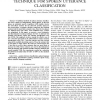Free Online Productivity Tools
i2Speak
i2Symbol
i2OCR
iTex2Img
iWeb2Print
iWeb2Shot
i2Type
iPdf2Split
iPdf2Merge
i2Bopomofo
i2Arabic
i2Style
i2Image
i2PDF
iLatex2Rtf
Sci2ools
TASLP
2008
2008
An Integrative and Discriminative Technique for Spoken Utterance Classification
Abstract-- Traditional methods of spoken utterance classification (SUC) adopt two independently trained phases. In the first phase, an automatic speech recognition (ASR) module returns the most likely sentence for the observed acoustic signal. In the second phase, a semantic classifier transforms the resulting sentence into the most likely semantic class. Since the two phases are isolated from each other, such traditional SUC systems are suboptimal. In this paper, we present a novel integrative and discriminative learning technique for SUC to alleviate this problem, and thereby, reduce the semantic classification error rate (CER). Our approach revolves around the effective use of the N-best lists generated by the ASR module to reduce semantic classification errors. The N-best list sentences are first rescored using all the available knowledge sources. Then, the sentence that is most likely to helps reduce the CER are extracted from the N-best lists as well as those sentences that are m...
Likely Semantic Class | Semantic Classification Errors | Spoken Utterance Classification | TASLP 2008 |
| Added | 15 Dec 2010 |
| Updated | 15 Dec 2010 |
| Type | Journal |
| Year | 2008 |
| Where | TASLP |
| Authors | Sibel Yaman, Li Deng, Dong Yu, Ye-Yi Wang, Alex Acero |
Comments (0)

